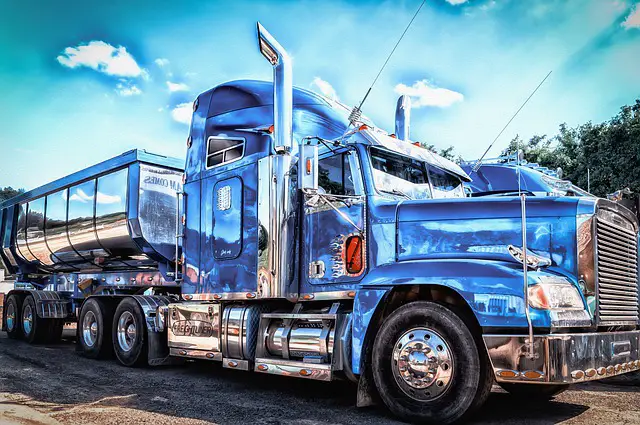
Anyone knows an 18-wheeler when they see one, right? Big, overpowering machines that can go for miles on all kinds of highways. Even though they are easy to recognize, not everyone knows much about them. But they can be easy to understand, too!
Semi-trucks or 18-wheelers?
You might have also heard the term “semi-truck” and not know the difference between the two. Well, they both refer to the same kind of truck! The reason why they are called “semi” is because of the trailer part of the truck. They are actually considered semi-trailers, because, while they are articulated, they do need to be connected and pulled in order to be moved.
Not really 18 wheels…
While they are called 18-wheelers, that is not exactly the case. Semi-trucks actually have a total of 19 wheels. Well, kinda… the odd one out (which IS actually called a fifth-wheel) is the central, round metal plate that connects the two parts together through the kingpin. The other pairs of wheels that are always together are called dualies. Their positioning like that is not only good to make the truck safer, but it helps distribute the weight of the truck better.
Start Your Engines
Semi-truck engines have to be incredibly potent in order to last through all the traveling and the heavy loads. They can have from 1000 to 2000 foot-pounds of torque and 600 horsepower (for diesel-run engines). Just so you can get a better picture, we’ll compare them to regular car engines: 18-wheeler trucks have 1800 more foot-pounds of torque, and have 300 or 400 more horsepower. But more impressively, they can last much longer than a usual car. Its lifespan exceeds that of regular cars by about 800,000 miles.
Hauling power
There is a reason why these semi-trucks are so huge. The average one-trailer 18-wheeler is capable of hauling as much as 80,000 pounds. This would apply to the 70-80 feet long ones. Of course, there are semi-trucks that can haul up much more than that. An Australian road-train, for instance, can carry a lot more – up to 300,000 pounds in total!
Braking Time
Because semi-trucks are usually so heavy and long, braking takes a little longer for them as it does for regular sedans. New drivers should be aware that the air brakes used by semi-trucks don’t work instantaneously, as they do on a car. On average, the distance an 18-wheeler might go before fulling stopping once the driver hits the brakes, when driving at 55 mph, is equivalent to two football fields. That is actually 40% longer than common vehicles. But besides the actual aspects of the truck, another factor that plays a role in braking time is the road. The smoother the road, the harder it is to create friction for braking. Most drivers are taught to look far ahead in order to know when to hit the brakes in time. They also only have 10 brakes rather than 18, as some might think, and they are required to have anti-lock brakes.
What Grinds Your Gears?
The total number of gears in an 18-wheeler can vary greatly. Most often, they’ll have about 10 forward gears and 2 reverse ones. But this is just the usual average! Semi-trucks can have as many as 18 gears, and as little as 9, even. As for the manual transmission, they can have anywhere between 12 and 18 gears.
Flap, Flap, Flap
It might not seem like it, but the flaps on a truck have a very specific, yet quite important role. They’re placed right underneath the trailer, on the back, and they help to improve performance. As all of the wind skirts under the trailer, they can reduce wind resistance as well as airflow around the trailer. This automatically reduce drag, therefore saving up on fuel.
Jackknifing? What?
Heard the term before, but you are not sure what it means? Jackknifing is a term used to describe the folding of the articulated part of the semi-truck, which is comprised of the kingpin. More specifically, it describes that folding when it is at a 45-degree angle. The truck will usually get into that position if it starts to skid, but the skid is not correct on time. That happens because the tractor is actually pushed back by the weight of the trailer behind it.
The Riskier, The Pricier
Driving a semi-truck comes with a lot of risks, and not just from the long hours that drivers have to make on every season of the year. The heavy loads, the skidding, the possible issues with brakes, all of that makes them driver at more risk, so their insurance is more expensive than a personal vehicle. Actually, they can be as much as 10 to 30 times pricier depending on the insurance provider.
Bed, Tract, and Beyond
As mentioned, truck drivers need to work long hours, and more often than not, they will need to sleep while on the road. But for budgetary and even time purposes, stopping at a hotel and have a full eight hours might not always be an option. Because of that, some semi-tractors might actually have a sleeping quarter. Along with a sleeping bunk, other tractors might also include miniature spaces big enough microwave oven, refrigerators, TVs… everything to make the trip more doable!
As of now, truck driving is bringing in a lot of money and helps fuel the economy on many levels. It is the pillar to industries like the food industry, the pharmaceutical industry, and many others that are vital for human survival. Most current data shows that truck drivers can make up to an average of $40,000 a year. Not too bad!
Leave a Reply